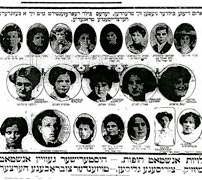
Eight months after the fire the district attorney determined the door to Asch Building's ninth floor stairway had been locked. Factory owners Max Blanck and Isaac Harris were indicted for manslaughter. At the trial defense attorney Max Steuer asserted that the story of the locked door had been fabricated. He also questioned the credibility of surviving workers who testified that the locked door blocked their escape. Judge Thomas Crain, a career Tammany Hall politician, instructed the jury that conviction required clear and convincing evidence that both the stairway door had been locked and the defendants knew the door was locked. The all male jury which included several businessmen acquitted Blanck and Harris after less than two hours of deliberation. When the defendants were released, outraged workers blocked the courthouse hallway, shouting in Yiddish “Murderers!”
CLICK ANY IMAGE TO ENLARGE WITH CAPTION















